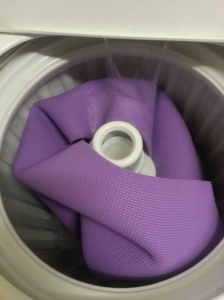For about a year now I have been making and using my homemade toothpaste. Most people cringe and wonder if it works. I am here to tell you that it does. I have never had a cavity, and my dental hygienist says my teeth and gums looks great.
Why did I stop using store-bought toothpaste? The answer is simple. I figured if the label says “do not swallow” and “if swallowed contact poison control” that it probably wasn’t a good thing to be putting in my mouth. It seems like a pretty easy task to keep our teeth clean, brushing and flossing and mouthwash isn’t too complicated of a routine, so why did toothpaste have to be complicated? Why does it have to contain sugar … something that causes tooth decay??? seems counter productive. Why does it have to contain nasty chemicals that can poison me? Why would I put that in my mouth? Okay, you get my point.
(this picture is from the first sample I made myself)
I’ve researched different toothpastes and tooth powders, tried some differing variations, and I have no concrete “recipe” to share with you. But here is my go to toothpaste ingredient list:
- coconut oil (organic)
- baking soda
- peppermint essential oil
- tea tree essential oil
- xylitol/stevia (optional)
- glass jar
I usually make a large batch (a couple jars at a time), sometimes I make some to give to my friends to try. But here is my general method:
- Melt some coconut oil in a small bowl or right in your glass jar. If this is your first batch, just make a little bit to try it out, a few tablespoons will do.
- Now add enough baking soda to the toothpaste to make a paste. (the paste consistency will be determined by the temperature of your house. In the summer the toothpaste can be more liquidy due to the heat, and in the winter very hard due to the cold)
- Now add 10-20 drops of peppermint essential oil. (Obviously, more or less depending on how much you are making)
- Now add 5-10 drops of tea tree oil.
- If you need to make it sweet like the store bought kind, this is where you add the xylitol or stevia to your taste. I made mine sweet at first when I was transitioning to natural toothpaste, now I leave it out completely.
You can also add other cleaning agents. I have heard of ground sage and bentonite clay being added. Also, you can leave out the coconut oil completely and make a toothpowder. People add sea salt to some tooth powders. It’s all about experimenting to see what you like and can tolerate.
To use, I just dip my brush head into the jar and get some on the bristles. I also use an electric toothbrush. I feel like it does a better job of using the grit from the baking soda to get my teeth nice and clean.
I will also be putting up my recipes for mouthwash and retainer/denture cleaner!
Until next time, I send you peace, love and good energy.
~Sharon







